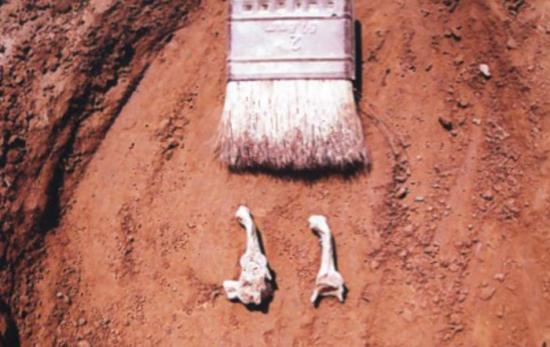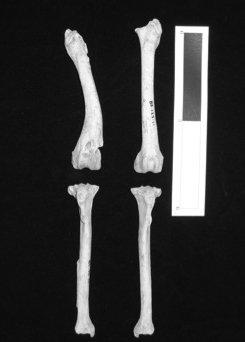Lacey Fleming
Source - http://www.redorbit.com/news/science/1113409496/how-ancient-north-americans-relied-on-dogs-for-survival-100115/
 Misshapen dog spinous processes from a site in middle Tennessee. Dogs that don’t carry or haul weight have perfectly straight spinous processes. (Credit: Lacey Fleming)
Misshapen dog spinous processes from a site in middle Tennessee. Dogs that don’t carry or haul weight have perfectly straight spinous processes. (Credit: Lacey Fleming)
One afternoon in September 2004, as an undergraduate student working on a CRM project in eastern Davidson County, Tennessee I was tasked with excavating what appeared to be an unremarkable circular feature. It was likely prehistoric given the site, and only visible because the soil inside the feature was considerably darker than the soil around it. Clearly it was evidence of some kind of past human activity, but we wouldn’t have any idea of what that might be until it was excavated. After half an hour of careful digging, what seemed to be the leg bones of a small, four-legged creature were visible. When I finished excavating, I realized I had uncovered the grave of a puppy, placed in the ground thousands of years ago, and—it seemed—with all the love and care a human might bury a beloved pet today.
 The puppy burial during excavation. (Credit: Lacey Fleming)
The puppy burial during excavation. (Credit: Lacey Fleming)
I don’t know why it hadn’t occurred to me before that afternoon that dogs accompanied the first humans on their journey into the Americas, or that the people who arrived later arrived on the continent likely would be traveling with dogs as well. After all, the dog is considered the first domesticated animal—the available archaeological and genetic evidence indicates it joined forces with us at least 20,000 years ago. The dog would have been an important ally as humans spread across the Americas, in part because it:
-
is good at barking; this habit of most dogs serves as an alarm, a deterrent, or both, against predators
-
has an excellent sense of smell that makes them invaluable hunting partners
-
has a tendency to clean up human refuse, which helps to keep away scavenging animals
My fascination with this puppy’s burial blossomed into a larger research project as I learned more dogs were interred in a similar manner at prehistoric sites throughout Tennessee. With many and various forms of assistance from Middle Tennessee State University’s Department of Sociology and Anthropology and the Tennessee Division of Archaeology, I was able to analyze the skeletal remains of the puppy, as well as those of nine dogs from four additional prehistoric contexts in Middle Tennessee, including both the Fernvale and Riverbend Prison sites. As a student of zooarchaeology, I was curious about the dogs’ size, and hoped I would be able to assign each to a sex and to determine how old they were at death. However, I was particularly interested in how the dogs had been regarded by humans during their lives. Were they merely pets, as their burials suggested?
During my analysis the following year, I read a paper by Walker et al. (2005) that discussed several dog burials from Dust Cave, a prehistoric site in northern Alabama. In that paper, they argued the Dust Cave dogs showed signs of having carried or hauled heavy items with their backs, an observation supported by an incredible amount of ethnohistoric data. Many of the Dust Cave dogs’ vertebral spinous processes (the knobby bits of bone you may feel as you pet a dog’s back) were deformed and/or misshapen. When archaeologists who study human or animal bone see these kinds of changes, we often attempt to identify what caused the bone to take on the new shape. Often these changes are linked to specific, habitual activities a human or animal carried out in life. These particular changes—or pathologies—prompted Walker and colleagues to consult with a group of university-based veterinary specialists who “unanimously concurred that the damage … was probably due to weight bearing down on that area of the dogs’ backs.” This means these dogs weren’t just pets or hunting companions—they were performing a crucial role in helping humans transport items across the landscape.
So of course I checked my dogs’ spinous processes. And wouldn’t you know…? (See feature image)
In sum, five of the ten prehistoric dogs I examined showed considerable evidence for the weight-bearing pathology. Of those who exhibited the pathology, four were identified positively as male by the presence of a baculum, or penis bone, and also were estimated to be the largest individuals in my sample. Overall, the weight and size estimates for these dogs ranged from small to medium, roughly corresponding to the dimensions of the modern-day rat terrier and Finnish spitz breeds.
 The hind legs of the Fernvale dog. Because the specimens are in correct anatomical position, the right leg is to the left of the frame. (Credit: Lacey Fleming)
The hind legs of the Fernvale dog. Because the specimens are in correct anatomical position, the right leg is to the left of the frame. (Credit: Lacey Fleming)
Interestingly, one of the dogs in my sample (from the Fernvale site in Williamson County) that didn’t have warped spinous processes experienced something else entirely. In 2012, I returned to this dog, a fully-grown male, whose right hind leg was severely misshapen. The ball-and-socket joint of the dog’s right hip was completely destroyed, yet showed signs of a naturally occurring repair. The dog’s upper leg bone also was broken, though it is not yet clear if this is related to his hip condition. Additionally, the dog’s lower right leg bones were fused together in an unusual way, suggesting the trauma to the right hip had implications for the dog’s entire leg, and that the leg may have been atrophied. My research on this dog is ongoing, though recently I have favored a disease-based interpretation of its skeletal pathologies, and I am investigating the possibility that the disease was readily transmissible between humans and dogs. Given the dog’s condition, it is tempting to suggest it required the daily ministrations of a human caregiver, although there are many examples of three-legged dogs who don’t need extraordinary human care. Perhaps more telling is the fact that this dog was interred alongside an elderly human female?
The life of an animal is written in part through its bones. In looking at these dogs’ skeletal materials, I have begun to piece together the kinds of daily activities they were carrying out, which helps to inform what humans who lived at the same time were doing. That dogs seem to have been used as traction animals thousands of years ago is a fascinating, yet generally underappreciated, aspect of life for the prehistoric inhabitants of North America. Zooarchaeology, once characterized as the part of archaeology that provides information on the meat component of ancient human diets, is trending toward new understandings of human-animal relationships in which the circumstances of animal lives are just as significant as their deaths. At this very moment, other scholars in Tennessee are taking our state’s prehistoric dog research to the next level, and I couldn’t be more excited to see what new insights will emerge in the near future!